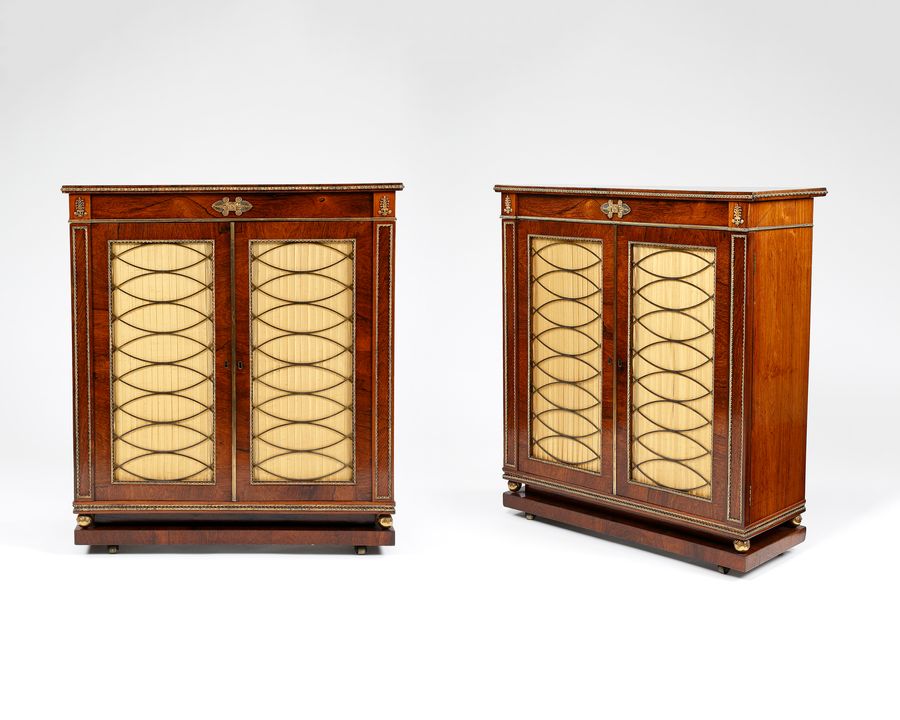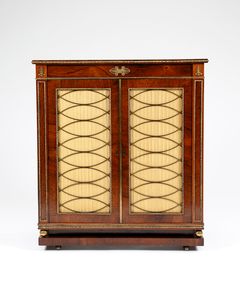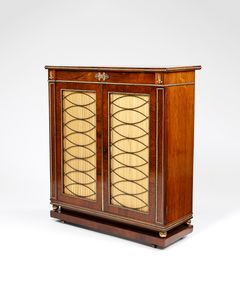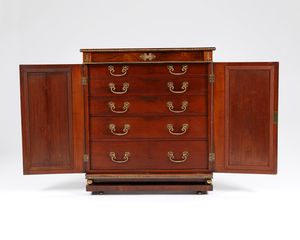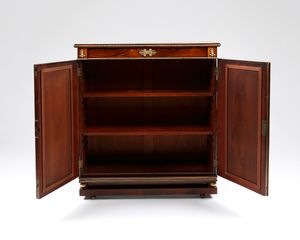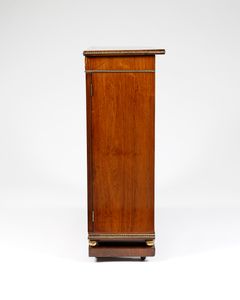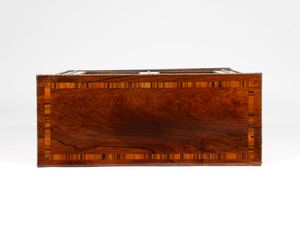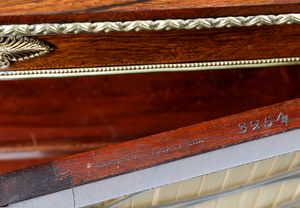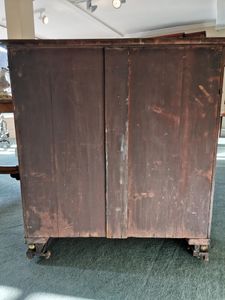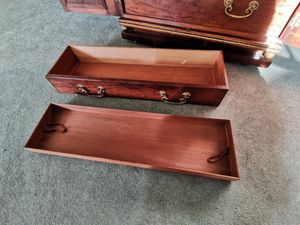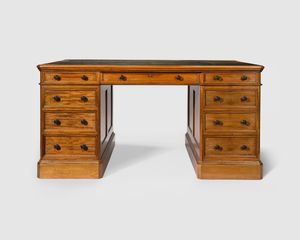Pair of rosewood and ormolu mounted Regency side cabinets
One cabinet is superbly fitted with drawers, the other with adjustable shelves.
Raised on small ball gilded feet and then onto a platform base which in turn are raised on castors for ease of movement.
Please read the following information on William Wilkinson.
Wilkinson, William, 14 Ludgate Hill, London, cm and u (1808–40). William Wilkinson had formerly been a partner with Thomas Wilkinson at Brokers Row, Moorfields but the partnership broke up soon after 1807 and by 1808 William was trading on his own account at Ludgate Hill. Thomas continued the business in Moorfields. At the Moorfields address the partners had shown an interest in patent furniture and especially tables. William clearly saw commercial advantage in promoting patent furniture at his new address and in October 1812 advertised patent bedsteads ‘which for their utter utility, firmness, and simplicity, surpass everything of the kind ever presented to the public: they effectually exclude vermin, and may be fixed and unfixed in five minutes’. He claimed to have several such beds in his showrooms where also were to be found ‘portable mahogany chairs, japanned chairs and portable dining tables and every other article made solid and warranted for any climate’. From its commencement the business was of substantial size and insurance cover in March 1808 was £2,000. In November 1824 Wilkinson was unfortunate to have a fire at the Ludgate Hill premises, possibly in a part used for manufacturing, as the address was given as Evangelist Ct, Ludgate Hill. William Wilkinson had a house at Highbury Grove at the time of his death, aged 70, on 29 May 1833. The business had traded from c. 1820 as William Wilkinson & Sons and after the death of their father the sons changed the trading style to William & Charles Wilkinson. Important commissions were received. In 1829 they were commissioned by the architect John Rennie to make a table which he presented to the Earl of Lonsdale at Lowther Castle. From 1833–34 they made furniture for the new Goldsmiths’ Hall in London to the designs of the architect Philip Hardwick. Much of this survives in the building. The furniture produced for the Court Room and the Court Dining-Room was of carved mahogany in the Grecian style but the Drawing Room furniture reflected the fact that this was a venue for pleasure with ladies present and the recently revived Rococo was used, the furniture being painted white with the detail gilt. The location of this firm in the City made them an obvious contender for patronage by the City Companies and in 1840 they were invited to tender for furniture and upholstery for the Armourers and Brasiers’ Co. In 1826 William Wilkinson & Sons signed the prefatory recommendation to P. & M. A. Nicholson's Practical Cabinet Maker.
The firm appear to have adopted a policy of stamping their products and a wide range of furniture in the Regency styles has been noted with this identification. Items so stamped include sofa tables, breakfast tables, extending dining tables, sets of tables, secrétaire bookcases, cabinets, chiffoniers, Davenports, chests of drawers, dining chairs, sideboards, wash stands and music or reading stands. Amongst these items is furniture in the Egyptian taste. Furniture was stamped ‘WILKINSON, LUDGATE HILL’ to c. 1820 then ‘WILKINSON & SONS 14 LUDGATE HILL’ to c. 1830 and ‘W & C WILKINSON, 14 LUDGATE HILL’ thereafter. Some furniture also had a serial number stamped after the name and numbers so far recorded range from 6585 to 19562. One extending dining table was stamped ‘WILKINSON, LATE KAY, 14 LUDGATE HILL, LONDON’. The premises in Ludgate Hill had been occupied by Quintin Kay from 1754 to 1807 and Wilkinson took them over very soon after Kay's death in July 1807. Pieces so stamped almost certainly date from the years immediately following the commencement of Wilkinson's business. [D; Times, 1 October 1812, 16 November 1824; GL, Sun MS vol. 441, ref. 814543; Gents Mag., 1824, p. 462, June 1833, p. 571; V&A archives; Joy, English Furniture 1800–1851, pp. 77, 151; Antiques, April 1952, p. 314; Collectors’ Guide, November 1947, p. 24; Sotheby's, 24 April ’64, lot 195, 10 June ’66, lot 195, 24 May ’68, lot 128, 19 July ’68, lot 161, 30 July ’71, lot 203, 29 September ’78, lot 142; Parke-Bernet NY, 1 February ’69, lot 99; Sotheby's Torquay, 30 September ’81; Christie's, 16 April ’81, lot 120, 16 July ’81, lot 128, 25 February ’82, lot 38; Phillips’, 27 November ’62, lot 103, 17 August ’82, lot 21; Bonham's, 21 April ’83, lot 127]
Condition
Very good
England
Rosewood, coramandel wood, ormolu
KCKC




 Back
Back